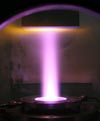| ||
|
 Русский Русский  English English |
Laboratory | Photo | GwLibrary |
Laboratory
- Unique Scientific Facilities. High frequency Induction Plasmatrons IPG-3 and IPG-4
- History of Plasma Lab
- Achievements
Unique Scientific Facilities. High frequency Induction Plasmatrons IPG-3 and IPG-4
Investigation and material testing in Induction Plasmatrons (Induction Plasma Generators) IPG-3 and IPG-4 are the major part of the Plasma Laboratory activity.
The IPG-3 and IPG-4 Plasmatrons are registered as the Unique Scientific Facilities in the Russian Federal Agency.
The details on this item – see in Russian page [in Russian only].
Photos of the Plasmatrons – see Photo.
History of Plasma Lab
History of the Laboratory for plasma and radiation/surface interaction, created together with the Institute, is indissolubly connected with development of the experimental base for solving the issues of aerodynamic heating re-entry hypersonic vehicles. In order to meet these issues the four induction RF-plasmatrons had been constructed: IPG-1 (1963–1977), IPG-2 (1977–1989), IPG-3 (1984–) and IPG-4 (1989–). M.I. Yakushin, who had been the head of the Laboratory since the first day until November 2001 put the two fundamental principles. The first one: to have the two facilities – R&D facility for investigations of plasma/material interactions physics and another one, more powerful engineering facility for testing elements of the thermal protection. That principle was realized in facilities IPG-4 and IPG-3. The second principle: joint work of the experimenters and theorists in order to accurately extrapolate the results of material testing to the hypersonic flight conditions.
In the laboratory have been studied and tested practically all the thermal protection materials developed at NPO "Energy" and "Molniya" for different space vehicles. The laboratory was engaged in the State program "Buran". At the first time the catalytic properties of the thermal protection materials with respect to atomic recombination were determined. Multicyclic (up to 100 cycles) testing thermal protection tiles of the "Buran" vehicle at the conditions, which simulate aerodynamic heating and material oxidation, were carried out.
In the frameworks of international ISTC and INTAS projects the theory and technical approach for simulation of thermochemical plasma/surface interaction for entrees of space vehicles in the Earth and Mars atmosphere were developed. At the last time in collaboration with ONERA (France) and VKI (Belgium) in the IPG-4 plasmatron catalytic properties and oxidation process of SiC material for trajectory parameters of European experimental space vehicles Pre-X and EXPERT were studied.
Up to now exploitation of RF-plasmatrons has confirmed correctness of technical and engineering solutions undertaken. At the present time the team and both facilities are claimed by Russian aerospace industry.
See also Laboratory of Interaction of Plasma and Radiation with Materials in IPMech RAS site.
Achievements
Yu.P. Raizer: The Laureate of Lenin Prize, 1966. Penning Award winner, 1993 (it was the prize of The International Scientific Committee on Ionized Gas Physics; one scientist was honored with this prize once for two year, at ICPIG Conference). The Laureate of State Prize of Russian Federation, 1999. Award of American Institute of Aeronautics and Astronautics (AIAA) on Plasmadynamics and Lasers, 2002. Honoured Science Worker of the Russian Federation.
V.V. Ragulsky: The Laureate of USSR State Prize, 1983. Corresponding academician of Russian Academy of Sciences.
A.F. Kolesnikov: The Laureate of USSR State Prize, 1988
Yu.K. Rulev: The medal for Valorous Labour.

